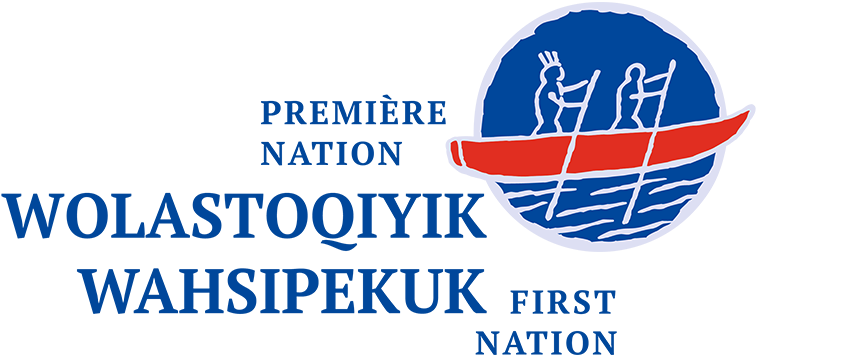

Home / Lessons / Level 1 / 3. Introduce Yourself
In this lesson, you will learn the basic concepts that will enable you to initiate a conversation in the wolastoqey language. You will learn the dialogues for introducing yourself, asking how the person you are talking to and saying goodbye.
Question: Qey ! Tan kahk olu kil ?  / Hello! How are you?
/ Hello! How are you?
Answer: Qey ! Mec-ote pesqon !  / Hello! I’m fine.
/ Hello! I’m fine.
Qey !  |
Hello! |
Tan  |
How |
Kahk  |
Particle meaning but; however; obviously and emphasizes the preceding word. |
Olu  |
Particle indicating a change in the direction of the conversation |
Kil  |
You |
Qey !  |
Hello! |
Mec-ote  |
Particle meaning again; still the same, it’s okay |
Pesqon  |
One, whole |
Nil  |
Me, I |
Ona  |
Also |
Woliwon !  |
Thank you! |
Dialogue example:
Person 1: Qey ! Tan kahk olu kil ?  / Hello! How are you?
/ Hello! How are you?
Person 2: Qey ! Mec-ote pesqon. Tan kahk olu kil ?  / Hello! I’m fine. How are you?
/ Hello! I’m fine. How are you?
Person 1: Nil ona, mec-ote pesqon, Woliwon !  / Me too, I’m fine. Thank you!
/ Me too, I’m fine. Thank you!
| - Key concept - | ||
|---|---|---|
| Before a noun or a verb, the particles «nil» or «kil» transform into simple «n» and «k» to indicate the first or second person respectively. | ||
Nil (Me, I)  |
Kil (You) | |
Nil-ona (Me too)  |
Ntoliwis (My name) | |
Kil-ona (You too)  |
Ktoliwis (Your name) | |
Question: Keq kil ktoliwis ?  / What’s your name?
/ What’s your name?
Answer: Ntoliwis nil Ahtuwen. Kil-olu tan ?  / My name is Anthony. And you?
/ My name is Anthony. And you?
Keq  |
What |
Kil  |
You |
Ktoliwis ?  |
What’s your name? |
Ntoliwis  |
My name is |
Nil  |
Me, I |
Ahtuwen  |
Anthony |
Kil-olu  |
You (+ particle indicating a change in direction of the conversation: and you?) |
Tan ?  |
How? |
Question: Apc-oc knomiyul !  / See you soon!
/ See you soon!
Answer: Aha ! Apc-oc knomiyul !  / Yes, see you soon!
/ Yes, see you soon!
Apc-oc  |
Particle meaning again, in the future |
Knomiyul  |
See you |
Aha !  |
Yes! |
| - Key concept - | |
|---|---|
Aha  |
Yes |
Ontama  |
No |
| - Key concept - | |
|---|---|
| In the wolastoqey language, the word "and" is said "naka". | |
Naka  |
And |
Kosona  |
Or |
Tan kal  |
I don’t know |
Nit-te psiw  |
That’s all |
Here are examples of sentence combinations that can be used to describe oneself by mentioning one’s name and favorite animal, or one’s name and nationality.
Dialogue example:
1 - Ntoliwis nil Ahtuwen naka nil muwin.  / My name is Anthony and I am a bear.
/ My name is Anthony and I am a bear.
2 - Ntoliwis nil Piyel naka nil Polecomon.  / My name is Peter and I am English.
/ My name is Peter and I am English.
Ntoliwis nil ...  |
My name is ... |
Naka  |
And |
Nil  |
Me, I |
Muwin  |
Bear |
Polecomon  |
English |
Indicate the appropriate pronoum for each statement.
| 1. | Ktoliwis Kalalin (Caroline) Ktoliwis kil Kalalin (Caroline). |
| 2. | Ntoliwis Pilips (Philippe). Ntoliwis nil Pilips (Philippe). |
| 3. | Ntoliwis Lula (Laurence). Ntoliwis nil Lula (Laurence). |
| 4. | Ktoliwis Sapiye (Xavier). Ktoliwis kil Sapiye (Xavier). |
| 5. | Ntoliwis Cacolin (Georges). Ntoliwis nil Cacolin (Georges). |
Choose the appropriate response to each of the questions.
Punctuation has been omitted in the answers to avoid giving clues about the correct one.
You need to prepare a name tag so that each animal can introduce itself.

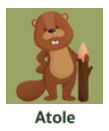

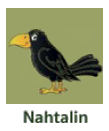
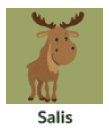





Peter and Mary meet for the first time. Complete their conversation.
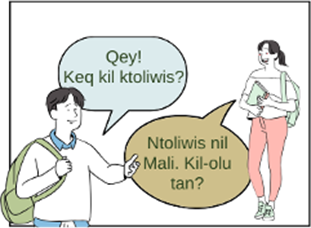






Fill in the grid with the Wolastoqey equivalents to the clues in English.
Additional information for exercises solutions may appear in the Appendix of the PDF document.